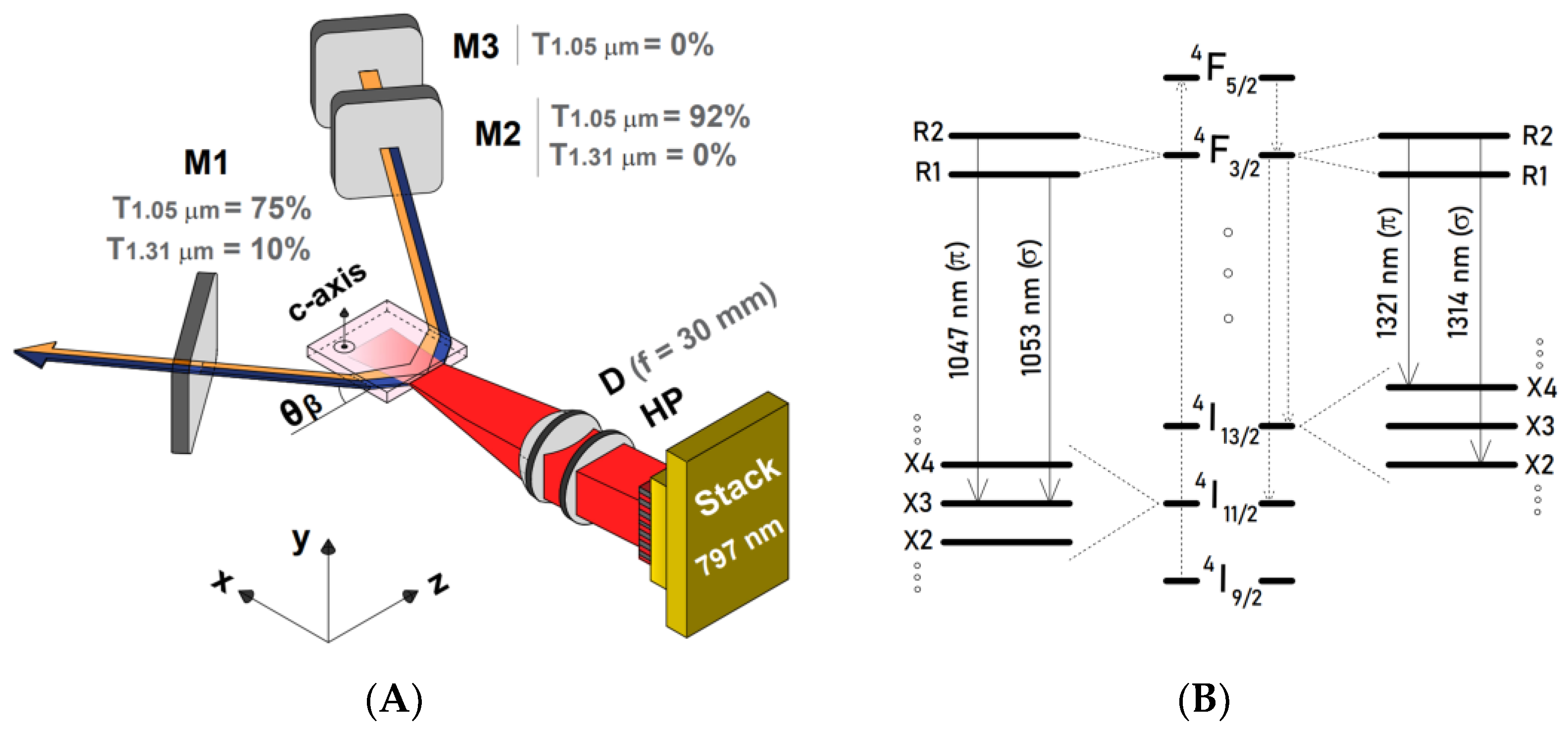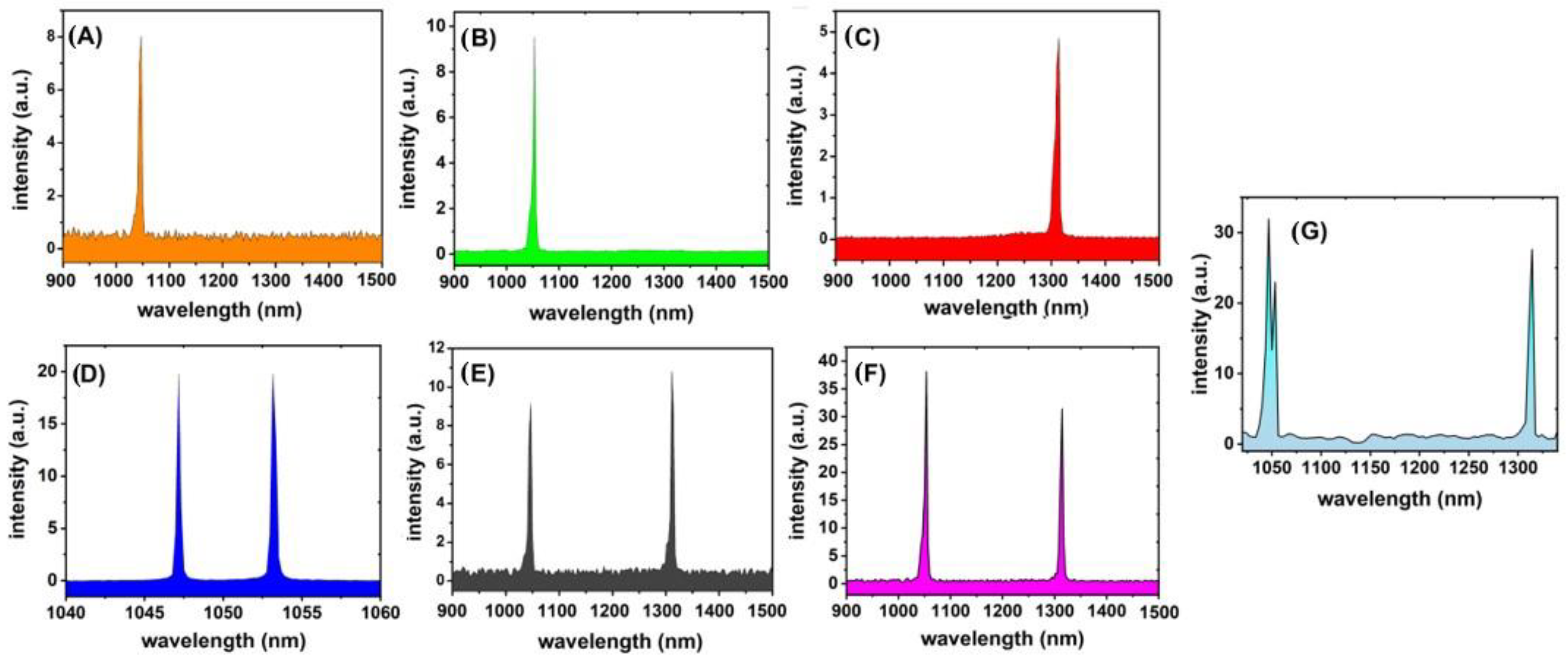Efficient Trichromatic Nd:YLF Laser Emitting at 1047 nm, 1053 nm and 1314 nm
Abstract
:1. Introduction
2. Materials and Methods
Wavelength Selection
3. Results and Discussion
4. Conclusions
Author Contributions
Funding
Institutional Review Board Statement
Informed Consent Statement
Data Availability Statement
Conflicts of Interest
References
- Pavel, N. Simultaneous Dual-Wavelength Emission at 0.90 and 1.06 µm in Nd-Doped Laser Crystals. Laser Phys. 2010, 20, 215–221. [Google Scholar] [CrossRef]
- Walsh, B.M. Dual Wavelength Lasers. Laser Phys. 2010, 20, 622–634. [Google Scholar] [CrossRef]
- Hussain, T.; Gondal, M.A. Laser Induced Breakdown Spectroscopy (LIBS) as a Rapid Tool for Material Analysis. J. Phys. Conf. Ser. 2013, 439, 012050. [Google Scholar] [CrossRef]
- Basler, C.; Brandenburg, A.; Michalik, K.; Mory, D. Comparison of Laser Pulse Duration for the Spatially Resolved Measurement of Coating Thickness with Laser-Induced Breakdown Spectroscopy. Sensors 2019, 19, 4133. [Google Scholar] [CrossRef]
- Basler, C.; Kappeler, M.; Carl, D. Depth-Resolved Elemental Analysis on Moving Electrode Foils with Laser-Induced Breakdown Spectroscopy. Sensors 2023, 23, 1082. [Google Scholar] [CrossRef] [PubMed]
- Ahmad, H.; Muhammad, F.D.; Pua, C.H.; Thambiratnam, K. Dual-Wavelength Fiber Lasers for the Optical Generation of Microwave and Terahertz Radiation. IEEE J. Sel. Top. Quantum Electron. 2014, 20, 166–173. [Google Scholar] [CrossRef]
- Angeluts, A.A.; Bezotosnyi, V.V.; Cheshev, E.A.; Goltsman, G.N.; Finkel, M.I.; Seliverstov, S.V.; Evdokimov, M.N.; Gorbunkov, M.V.; Kitaeva, G.K.; Koromyslov, A.L. Compact 1.64 THz Source Based on a Dual-Wavelength Diode End-Pumped Nd:YLF Laser with a Nearly Semiconfocal Cavity. Laser Phys. Lett. 2014, 11, 015004. [Google Scholar] [CrossRef]
- Polyakov, V.M.; Vitkin, V.V.; Lychagin, D.I.; Krylov, A.A.; Buchenkov, V.A.; Kashcheev, S.V. Compact Q-Switched High Repetition Rate Nd:YLF Laser with 100 MJ Pulse Energy for Airborne Lidars. In Proceedings of the 2014 International Conference Laser Optics, St. Petersburg, Russia, 30 June–4 July 2014; IEEE Computer Society: Piscataway, NJ, USA, 2014. [Google Scholar]
- Geskus, D.; Jakutis-Neto, J.; Pask, H.M.; Wetter, N.U. Intracavity Frequency Converted Raman Laser Producing 10 Deep Blue to Cyan Emission Lines with up to 094 W Output Power. Opt. Lett. 2014, 39, 6799–6802. [Google Scholar] [CrossRef] [PubMed]
- Ferreira, M.S.; Wetter, N.U. Diode-Side-Pumped, Intracavity Nd:YLF/KGW/LBO Raman Laser at 573 Nm for Retinal Photocoagulation. Opt. Lett. 2021, 46, 508–511. [Google Scholar] [CrossRef]
- Geskus, D.; Neto, J.J.; Reijn, S.-M.; Pask, H.M.; Wetter, N.U. Quasi-Continuous Wave Raman Lasers at 990 and 976 Nm Based on a Three-Level Nd:YLF Laser. Opt. Lett. 2014, 39, 2982–2985. [Google Scholar] [CrossRef] [PubMed]
- Demirbas, U.; Uecker, R.; Fujimoto, J.G.; Leitenstorfer, A. Multicolor Lasers Using Birefringent Filters: Experimental Demonstration with Cr:Nd:GSGG and Cr:LiSAF. Opt. Express 2017, 25, 2594–2607. [Google Scholar] [CrossRef]
- Wetter, N.U.; Camargo, F.A.; Sousa, E.C. Mode-Controlling in a 7.5 cm Long, Transversally Pumped, High Power Nd:YVO4 Laser. J. Opt. A Pure Appl. Opt. 2008, 10, 104012. [Google Scholar] [CrossRef]
- Deana, A.M.; Ranieri, I.M.; Baldochi, S.L.; Wetter, N.U. Compact, Diode-Side-Pumped and Q-Switched Nd:YLiF4 Laser Cavity Operating at 1053 Nm with Diffraction Limited Beam Quality. Appl. Phys. B 2012, 106, 877–880. [Google Scholar] [CrossRef]
- Zhang, G.; Liu, T.; Shen, Y.; Zhao, C.; Huang, B.; Kang, Z.; Qin, G.; Liu, Q.; Fu, X. 516 mW, nanosecond Nd:LuAG laser Q-switched by gold nanorods. Chin. Opt. Lett. 2018, 16, 030011. [Google Scholar] [CrossRef]
- Jahid, A.; Alsharif, M.H.; Hall, T.J. A Contemporary Survey on Free Space Optical Communication: Potentials, Technical Challenges, Recent Advances and Research Direction. J. Netw. Comput. Appl. 2022, 200, 103311. [Google Scholar] [CrossRef]
- Kores, C.C.; Jakutis-Neto, J.; Geskus, D.; Pask, H.M.; Wetter, N.U. Diode-Side-Pumped Continuous Wave Nd3+:YVO4 Self-Raman Laser at 1176 nm. Opt. Lett. 2015, 40, 3524–3527. [Google Scholar] [CrossRef]
- Czeranowsky, C. Resonatorinterne Frequenzverdopplung von Diodengepumpten Neodym-Lasern Mit Hohen Ausgangsleistungen Im Blauen Spektralbereich; University of Hamburg: Hamburg, Germany, 2002. [Google Scholar]
- Koechner, W.; Bass, M. Solid-State Lasers: Advanced Texts in Physics; Springer: New York, NY, USA, 2003; ISBN 978-0-387-95590-2. [Google Scholar]
- Nunez Portela, M.; Wetter, N.U.; Zondy, J.J.; Cruz, F.C. A Single-Frequency, Diode-Pumped Nd:YLF Laser at 657 Nm: A Frequency and Intensity Noise Comparison with an Extended Cavity Diode Laser. Laser Phys. 2013, 23, 025801. [Google Scholar] [CrossRef]
- Vollmar, W.; Knights, M.G.; Rines, G.A.; Mccarthy, J.C.; Chicklis, E.P. Five-Color Nd:YLF Laser. In Proceedings of the Conference on Lasers and Electro-Optics, Baltimore, MD, USA, 17–20 May 1983; OSA: Washington, DC, USA, 1983; p. THM2. [Google Scholar]
- Wetter, N.U.; Deana, A.M. Influence of Pump Bandwidth on the Efficiency of Side-Pumped, Double-Beam Mode-Controlled Lasers: Establishing a New Record for Nd:YLiF4 Lasers Using VBG. Opt. Express 2015, 23, 9379–9387. [Google Scholar] [CrossRef] [PubMed]
- Damzen, M.J.; Trew, M.; Crofts, G.J.; Rosas, E. 22.5W Continuous-Wave Nd:YVO4 Grazing-Incidence Laser with 62% Conversion Efficiency. In Proceedings of the Advanced Solid-State Lasers, Seattle, WA, USA, 28–31 January 2001; OSA: Washington, DC, USA, 2001; p. MD4. [Google Scholar]
- Damzen, M.J.; Trew, M.; Rosas, E.; Crofts, G.J. Continuous-Wave Nd:YVO4 Grazing-Incidence Laser with 22.5 W Output Power and 64% Conversion Efficiency. Opt. Commun. 2001, 196, 237–241. [Google Scholar] [CrossRef]
- Prado, F.M.; Franco, T.J.; Vieira, T.A.; Wetter, N.U. High Power Nd:YLF Four-Level Lasers with 68% Slope Efficiency. Appl. Opt. 2023, 62, C49–C52. [Google Scholar] [CrossRef]
- Prado, F.; Wetter, N.U. Nd:YLF Laser Pumped at 797 Nm with 68% Slope Efficiency. In Proceedings of the Solid State Lasers XXXI: Technology and Devices, San Francisco, CA, USA, 22–27 January 2022; Clarkson, W.A., Shori, R.K., Eds.; SPIE: Bellingham, WA, USA, 2022; p. 18. [Google Scholar]
- Wetter, N.U.; Deana, A.M. Diode-Side-Pumped Nd:YLiF4 Laser Emitting at 1053 nm with 53.6% Optical Efficiency and Diffraction-Limited Beam Quality. Laser Phys. Lett. 2013, 10, 035807. [Google Scholar] [CrossRef]
- Deana, A.M.; Lopez, M.A.P.A.; Wetter, N.U. Diode-Side-Pumped Nd:YLF Laser Emitting at 1313 Nm Based on DBMC Technology. Opt. Lett. 2013, 38, 4088–4091. [Google Scholar] [CrossRef]
- Vieira, T.A.; Prado, F.M.; Wetter, N.U. Nd:YLF Laser at 1053 Nm Diode Side Pumped at 863 nm with a near Quantum-Defect Slope Efficiency. Opt. Laser Technol. 2022, 149, 107818. [Google Scholar] [CrossRef]
- Vieira, T.A.; Prado, F.M.; Wetter, N.U. Near Quantum Limited Slope Efficiency Nd:YLF4 Laser. In Proceedings of the Laser Congress 2021 (ASSL, LAC), Washington, DC, USA, 3–7 October 2021; Optica Publishing Group: Washington, DC, USA, 2021; p. AW3A.6. [Google Scholar]
- Prado, F.M.; Franco, T.J.; Wetter, N.U. Sub-Nanosecond, 41 MJ Pulse Energy, Passively Q-Switched Nd:YLF Laser. Opt. Laser Technol. 2023, 162, 109257. [Google Scholar] [CrossRef]
- Yu, H.; Wu, K.; Yao, B.; Zhang, H.; Wang, Z.; Wang, J.; Zhang, X.; Jiang, M. Efficient Triwavelength Laser with a Nd:YGG Garnet Crystal. Opt. Lett. 2010, 35, 1801–1803. [Google Scholar] [CrossRef] [PubMed]
- Hou, J.; Zheng, L.H.; He, J.L.; Xu, J.; Zhang, B.T.; Wang, Z.W.; Lou, F.; Wang, R.H.; Liu, X.M. A Tri-Wavelength Synchronous Mode-Locked Nd:SYSO Laser with a Semiconductor Saturable Absorber Mirror. Laser Phys. Lett. 2014, 11, 035803. [Google Scholar] [CrossRef]
- Lin, Z.; Wang, Y.; Xu, B.; Xu, H.; Cai, Z. Diode-Pumped Simultaneous Multi-Wavelength Linearly Polarized Nd:YVO4 Laser at 1062, 1064 and 1066 nm. Laser Phys. 2016, 26, 015801. [Google Scholar] [CrossRef]
- Chen, L.; Wang, Z.; Liu, H.; Zhuang, S.; Yu, H.; Guo, L.; Lan, R.; Wang, J.; Xu, X. Continuous-Wave Tri-Wavelength Operation at 1064, 1319 and 1338 Nm of LD End-Pumped Nd:YAG Ceramic Laser. Opt. Express 2010, 18, 22167–22173. [Google Scholar] [CrossRef]
- Xu, B.; Camy, P.; Doualan, J.-L.; Braud, A.; Cai, Z.; Balembois, F.; Moncorgé, R. Frequency Doubling and Sum-Frequency Mixing Operation at 4692, 471, and 473 Nm in Nd:YAG. J. Opt. Soc. Am. B 2012, 29, 346–350. [Google Scholar] [CrossRef]
- Tu, Z.; Dai, S.; Zhu, S.; Yin, H.; Li, Z.; Ji, E.; Chen, Z. Efficient High-Power Orthogonally-Polarized Dual-Wavelength Nd:YLF Laser at 1314 and 1321 nm. Opt. Express 2019, 27, 32949–32957. [Google Scholar] [CrossRef] [PubMed]
- Cho, C.Y.; Huang, T.L.; Wen, S.M.; Huang, Y.J.; Huang, K.F.; Chen, Y.F. Nd:YLF Laser at Cryogenic Temperature with Orthogonally Polarized Simultaneous Emission at 1047 nm and 1053 nm. Opt. Express 2014, 22, 25318–25323. [Google Scholar] [CrossRef]
- Turri, G.; Webster, S.; Bass, M.; Toncelli, A. Temperature-Dependent Stimulated Emission Cross-Section in Nd3+:YLF Crystal. Materials 2021, 14, 431. [Google Scholar] [CrossRef] [PubMed]
- Xu, S.; Gao, S. A New Wavelength Laser at 1370 nm Generated by Nd:YLF Crystal. Mater. Lett. 2016, 183, 451–453. [Google Scholar] [CrossRef]
- Pollnau, M.; Hardman, P.J.; Kern, M.A.; Clarkson, W.A.; Hanna, D.C. Upconversion-Induced Heat Generation and Thermal Lensing in Nd:YLF and Nd:YAG. Phys. Rev. B 1998, 58, 16076–16092. [Google Scholar] [CrossRef]
- Kubodera, K.; Otsuka, K. Single-Transverse-Mode LiNdP4O12 Slab Waveguide Laser. J. Appl. Phys. 1979, 50, 653–659. [Google Scholar] [CrossRef]
- Siegman, A.E. Choice of Clip Levels for Beam Width Measurements Using Knife-Edge Techniques. IEEE J. Quantum Electron. 1991, 27, 1098–1104. [Google Scholar] [CrossRef]
- Siegman, A.E. How to (Maybe) Measure Laser Beam Quality. In Proceedings of the DPSS (Diode Pumped Solid State) Lasers: Applications and Issues, Washington, DC, USA, 1–4 December 1998; OSA: Washington, DC, USA, 1998; p. MQ1. [Google Scholar]






| Nd:YLF | 4F3/2 → 4I11/2 | 4F3/2 → 4I13/2 | ||
|---|---|---|---|---|
| 1047 nm (π) | 1053 nm (σ) | 1321 nm (π) | 1314 nm (σ) | |
| σe (10−19 cm2) | 1.8 | 1.2 | 0.27 | 0.33 |
| Nd:YLF Laser | Laser Emission Regime | ||||||
|---|---|---|---|---|---|---|---|
| 1314 nm | 1047 nm | 1053 nm | 1047 + 1053 nm | 1047 + 1314 nm | 1053 + 1314 nm | 1047 + 1053 + 1314 nm | |
| Peak Output Power (W) | 726 ± 3 | 434 ± 11 | 124 ± 1 | 514 ± 4 | 400 ± 9 | 102 ± 1 | 574 ± 3 |
| Pulse width (µs) | 342 ± 0.1 | 315 ± 1 | 338 ± 2 | 332 ± 0.2 | 314 ± 1 | 335 ± 1 | 331 ± 0.2 |
| Slope efficiency (%) | 53 ± 1 | 35 ± 1 | 43 ± 0.5 | 39 ± 0.5 | 31 ± 0.5 | 41 ± 0.4 | 42 ± 1 |
| Optical efficiency (%) | 49 ± 0.3 | 29 ± 1 | 40 ± 0.2 * | 34 ± 0.3 | 27 ± 1 | 37.5 ± 0.2 * | 38 ± 0.3 |
| Wavelength | ||
|---|---|---|
| x | y | |
| 1314 nm | 4.2 ± 0.1 | 2.93 ± 0.4 |
| 1047 nm | 2.4 ± 0.3 | 2.2 ± 0.4 |
| 1053 nm | 4.1 ± 0.2 | 2.4 ± 0.1 |
Disclaimer/Publisher’s Note: The statements, opinions and data contained in all publications are solely those of the individual author(s) and contributor(s) and not of MDPI and/or the editor(s). MDPI and/or the editor(s) disclaim responsibility for any injury to people or property resulting from any ideas, methods, instructions or products referred to in the content. |
© 2023 by the authors. Licensee MDPI, Basel, Switzerland. This article is an open access article distributed under the terms and conditions of the Creative Commons Attribution (CC BY) license (https://creativecommons.org/licenses/by/4.0/).
Share and Cite
Prado, F.M.; Franco, T.J.; Wetter, N.U. Efficient Trichromatic Nd:YLF Laser Emitting at 1047 nm, 1053 nm and 1314 nm. Photonics 2023, 10, 1146. https://doi.org/10.3390/photonics10101146
Prado FM, Franco TJ, Wetter NU. Efficient Trichromatic Nd:YLF Laser Emitting at 1047 nm, 1053 nm and 1314 nm. Photonics. 2023; 10(10):1146. https://doi.org/10.3390/photonics10101146
Chicago/Turabian StylePrado, Felipe Maia, Tomás Junqueira Franco, and Niklaus Ursus Wetter. 2023. "Efficient Trichromatic Nd:YLF Laser Emitting at 1047 nm, 1053 nm and 1314 nm" Photonics 10, no. 10: 1146. https://doi.org/10.3390/photonics10101146
APA StylePrado, F. M., Franco, T. J., & Wetter, N. U. (2023). Efficient Trichromatic Nd:YLF Laser Emitting at 1047 nm, 1053 nm and 1314 nm. Photonics, 10(10), 1146. https://doi.org/10.3390/photonics10101146





